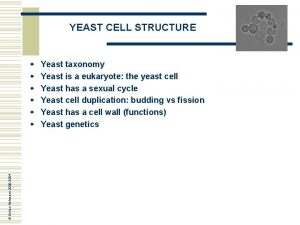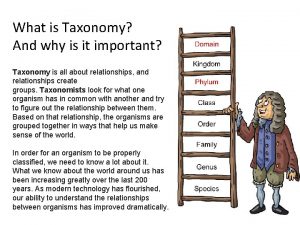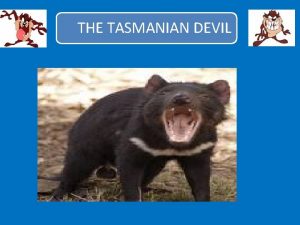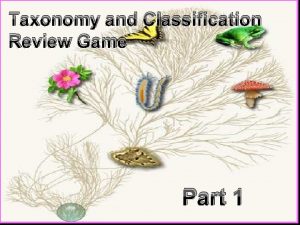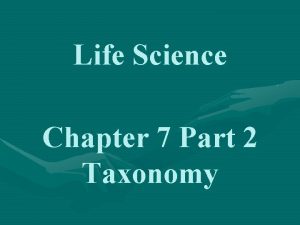Unit H Taxonomy Part 1 What is Taxonomy







































- Slides: 39

Unit H: Taxonomy

Part 1: What is Taxonomy? Objectives: • Define classification and taxonomy • Describe the history of taxonomy • Identify the 7 major taxa • Classify organisms using binomial nomenclature

Affixes & Roots • Taxa = groups • Nome = name

What is Taxonomy? • classification = the grouping of objects or information based on similarities • taxonomy = the branch of biology that groups and names organisms based on their different characteristics

The history • Aristotle developed the first widely accepted system of biological classification. • There were two main groups: plants and animals.

Aristotle’s issues… • He grouped animals by various characteristics, including habitat. • Air, land or water. How would you categorize the duck?

Carolus Linnaeus • In the late 18 th century he developed a method of grouping organisms based on physical and structural similarities. • This modern method uses a two-word naming system called binomial nomenclature. • Bi = 2, nome = name

Binomial Nomeclature • uses Latin, a dead language to name organisms. • Dead languages don’t change. • All scientists now have one name for each organism, for example: • Felis concolor

Taxonomic Divisions (Taxa) Broad (less specific) Narrow (more specific) There are eight taxa: Mnemonic device • Domain • Dirty • Kingdom • King • Phylum • Phillip • Class • Came • Order • Over • Family • From • Genus • Greece • Species Used for • Singing naming

Use this chart to find the binomial names of the 7 animals below

Answers… 1. 2. 3. 4. 5. 6. 7. Felis catus Felis pardalis Panthera pardus Canis familiaris Canis lupus Ursus arctos Ursus horribilus

Summary Questions: Part 1 1. The branch of Biology that deals with grouping organisms based upon shared traits is called: ______ 2. The system of naming organisms using two names is called ________. 3. List the 7 major taxa in order.

Part 2: The 6 Kingdoms Objectives: • Describe how scientists classify organisms • Identify the major characteristics of the 6 kingdoms of life

How do taxonomists classify organisms? • Structural Similarities • Breeding Behavior • Geographical Distribution • Chromosomes Comparisons • Biochemistry

Domains • Eukarya – all eukaryotes • Archaea – extremist prokaryotes • Bacteria – common prokaryotes

Autotrophs There are 6* Kingdoms. Heterotrophs Both *This is in dispute and if you take Biology in college, you will probably learn this differently. Please don’t sue me.

Animalia (Animals) • Most diverse kingdom (most # species) • Multicellular, eukaryotic • Most can move in some way (motile) • Heterotrophs




Fig. 33 -13 Jaws Anus Stomach Crown of cilia 0. 1 mm


Plantae (Plants) • Multicellular, eukaryotic • Cells surrounded by cell wall • Mostly autotrophic, but some are “mixotrophs” • Most reproduce using spores (pollen)

Fig. 29 -13 -3 Plant life cycle Key Haploid (n) Diploid (2 n) MEIOSIS Spore dispersal Spore (n) Sporangium Antheridium Young gametophyte Mature gametophyte (n) Archegonium Mature sporophyte (2 n) Egg New sporophyte Zygote (2 n) Sorus Gametophyte Fiddlehead FERTILIZATION Sperm

Fig. 30 -6 -4 Key Haploid (n) Diploid (2 n) Ovule Ovulate cone Pollen cone Integument Microsporocytes (2 n) Mature sporophyte (2 n) Megasporocyte (2 n) Megasporangium (2 n) Pollen grain MEIOSIS grains (n) MEIOSIS Microsporangia Microsporangium (2 n) Seedling Surviving megaspore (n) Archegonium Female gametophyte Seeds Food reserves (n) Seed coat (2 n) Embryo (2 n) Sperm nucleus (n) Pollen tube FERTILIZATION Egg nucleus (n)

Fungi (Mushrooms) • Multi or unicellular • Eukaryotic, heterotrophs • Cell walls contain chitin, which also makes up insect exoskeletons • Largest organism on the planet is a fungus


Protista (protists) • Multicellular and unicellular • Lack organs • Some are animal-like heterotrophs, others are more like plants (autotrophs), and others are fungi like • Slime molds, algae • Technically not a kingdom anymore

Fig. 28 -14 Flagellum Outer container Living cell 25 µm



Fig. 28 -15 Blade Stipe Holdfast


Eubacteria • Microscopic, unicellular prokaryotes • Form colonies • Live in the body of other organisms (gut) • Some cause diseases • Gram positive (blue) or Gram negative (pink)

Neisseria gonnorrhoeae Streptococcus pnemoniae

E. coli

Archaebacteria • Unicellular, prokaryotic • Most live in extreme conditions (extremophiles) • Recently discovered


Summary Questions – Part 2 1. Scientists currently recognize ___ Kingdoms. 2. _____are multicellular, heterotrophic organisms capable of movement 3. _____can be multicellular or unicellular; some are more like plants, others are more like animals 4. _____ are bacteria that are usually found in extreme conditions
 Marzano taxonomy chart
Marzano taxonomy chart Unit 6 review questions
Unit 6 review questions Unit 15 plant structures and taxonomy
Unit 15 plant structures and taxonomy Unit 2 plant taxonomy how plants are named
Unit 2 plant taxonomy how plants are named Addition symbol
Addition symbol Unit ratio definition
Unit ratio definition Brainpop ratios
Brainpop ratios Define technical description
Define technical description Basic parts of a bar
Basic parts of a bar The part of a shadow surrounding the darkest part
The part of a shadow surrounding the darkest part Two way anova minitab 17
Two way anova minitab 17 Unit 7 part 1 ap psychology
Unit 7 part 1 ap psychology Rotational inertia and torque
Rotational inertia and torque Notes 6-6: properties of kites and trapezoids
Notes 6-6: properties of kites and trapezoids System of equations and inequalities unit test
System of equations and inequalities unit test Expressions equations and inequalities unit test
Expressions equations and inequalities unit test External parts of cpu
External parts of cpu Representativeness heuristic
Representativeness heuristic Linear systems unit test part 1
Linear systems unit test part 1 Unit test review algebra 2
Unit test review algebra 2 Unit 6 part 2
Unit 6 part 2 Unit 7 progress check: mcq part c
Unit 7 progress check: mcq part c Intro to quadratics
Intro to quadratics Unit 6 part 1
Unit 6 part 1 Suatu lembaga yang
Suatu lembaga yang Hyp opp adj triangle
Hyp opp adj triangle English unit conversions
English unit conversions Algebra 2 unit 1 test
Algebra 2 unit 1 test Perhitungan unit cost rekam medis
Perhitungan unit cost rekam medis Unit process and unit operation
Unit process and unit operation Difference between unit process and unit operation
Difference between unit process and unit operation Kerangka konseptual standar akuntansi pemerintahan
Kerangka konseptual standar akuntansi pemerintahan Yeast taxonomy
Yeast taxonomy Halimbawa ng affective domain
Halimbawa ng affective domain What is taxonomy and why is it important
What is taxonomy and why is it important Virtualization reference model
Virtualization reference model Mnemonic for taxonomy
Mnemonic for taxonomy Taxonomy of bugs in stm
Taxonomy of bugs in stm Thermodynamics is the branch of science that deals with
Thermodynamics is the branch of science that deals with Tasmanian devil habitat
Tasmanian devil habitat
































